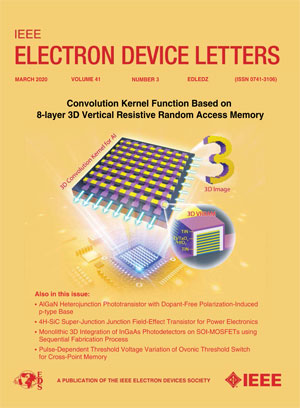基于Ga₂O₃的光电突触与压电/光门控调制用于多模态感知
IF 4.5
2区 工程技术
Q2 ENGINEERING, ELECTRICAL & ELECTRONIC
引用次数: 0
摘要
Ga2O3利用高深紫外(DUV)响应性和持久光电导率(PPC)来实现低功耗突触器件。然而,现有Ga2O3突触中有限的PPC弛豫可控性限制了可调塑性。这项工作展示了一种用于多模态感知的压电/光控调制Ga2O3/ZnO突触装置。该器件在254 nm光脉冲下表现出可重构的突触可塑性,包括成对脉冲促进、短期到长期的可塑性转变和动态重量调制。最重要的是,压缩应变(-0.57%)使突触重量变化增加了22%(从1076.3%增加到1310.2%),这是由于异质结界面应变引起的能带弯曲,从而调节载流子分离和氧空位复合。这种应变调制行为可以实现对人体的智能医疗保健,其中心电图模式识别使用单层神经网络达到83.5%的准确率。本研究为开发具有传感-记忆-处理协同集成能力的人工触觉-感知系统功能可调光电突触建立了一种可行的方法。本文章由计算机程序翻译,如有差异,请以英文原文为准。
Ga₂O₃-Based Optoelectronic Synapse With Piezo/Photo-Gated Modulation for Multimodal Perception
Ga2O3 leverage high deep-ultraviolet (DUV) responsivity and persistent photoconductivity (PPC) to enable low-power synaptic devices. However, limited PPC relaxation controllability in existing Ga2O3 synapses restricts tunable plasticity. This work demonstrates a piezo/photo-gated modulated Ga2O3/ZnO synaptic device for multimodal perception. The device exhibits reconfigurable synaptic plasticity—including paired-pulse facilitation, short-to-long-term plasticity transition, and dynamic weight modulation—under 254 nm light pulses. Crucially, compressive strain (-0.57%) enhances synaptic weight change by 22% (from 1076.3% to 1310.2%), attributed to strain-induced band bending at the heterojunction interface that regulates carrier separation and oxygen vacancy recombination. This strain-modulated behavior enables intelligent health care to the human body, where electrocardiogram pattern recognition achieves 83.5% accuracy using a single-layer neural network. This study establishes a viable approach for developing functionally tunable photoelectric synapses with co-integrated sensing-memory-processing capabilities for artificial tactile-perception systems.
求助全文
通过发布文献求助,成功后即可免费获取论文全文。
去求助
来源期刊

IEEE Electron Device Letters
工程技术-工程:电子与电气
CiteScore
8.20
自引率
10.20%
发文量
551
审稿时长
1.4 months
期刊介绍:
IEEE Electron Device Letters publishes original and significant contributions relating to the theory, modeling, design, performance and reliability of electron and ion integrated circuit devices and interconnects, involving insulators, metals, organic materials, micro-plasmas, semiconductors, quantum-effect structures, vacuum devices, and emerging materials with applications in bioelectronics, biomedical electronics, computation, communications, displays, microelectromechanics, imaging, micro-actuators, nanoelectronics, optoelectronics, photovoltaics, power ICs and micro-sensors.
 求助内容:
求助内容: 应助结果提醒方式:
应助结果提醒方式:


